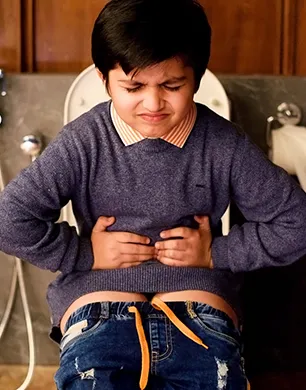Diarrhoea Symptoms - Stomach pain & dehydration
Signs and Symptoms of Diarrhoea
It’s safe to say that an unrest of any kind in the stomach first manifests as stomach pain. Apart from conditions like intestinal swelling, irregularity or diarrhoea, kids can face different kinds of stomach pain.

Abdominal pain
Diarrhoea symptoms include abdominal pain. This pain can be constant or sporadic- it comes and goes and can be of different intensity. It’s like the pain caused by cramps. If there’s a bacterial or viral infection affecting the stomach and the intestine, the abdominal pain is accompanied by other symptoms such as nausea, vomiting, diarrhoea, fever, paleness.
What should you do in this case?*
If there’s a cramping pain, heat therapy can be useful. If the pain is accompanied by vomiting it is advisable to follow the paediatrician's dietary advice. If there’s constipation, increasing fluid and fiber intake is a good practice. If symptoms persist, please consult your paediatrician.
Colic
Colic is when there’s severe pain in the abdomen of babies, caused by wind or obstruction in the intestines. As a result, the baby cries incessantly, for a long time at a stretch. A way of recognising this is when along with crying, the baby pulls the legs towards the abdomen and releases gas frequently. The usual cause of this is the ingestion of air during lactation and intestinal fermentation of breast milk.
What should you do in this case?**
Make the baby burp. Try a delicate massage. Walk while holding the baby on the stomach with one hand under the stomach, or rocking it with a rocking chair, a seat or a stroller. Try to stay calm, as your agitation could transcend to the baby. Keep the child in a quiet environment.
Dehydration
Dehydration is a common consequence of diarrhoea. It occurs when you lose more fluid than you take in, and your body doesn't have enough fluids to carry out its normal functions. If you don't replace lost fluids, you will get dehydrated. After diarrhoea it’s important to restore your, or your child’s, health and intestinal flora if you spot dehydration. Which brings us to- how will you spot dehydration?
Symptoms of Dehydration in Kids:
- Sunken eyes
- Decreased frequency of urination or dry diapers for over 3 hours
- Sunken soft spot on the front of the head in babies (called the fontanel)
- No tears when the child cries
- Dry or sticky mucous membranes (the lining of the mouth or tongue)
- Lethargy (less than normal activity)
- Irritability (more crying, fussiness with inconsolability)
- High fever above 102 deg F
- Dry lips, mouth and tongue
- Bloody or black stool
- Severe vomiting
- Loss of skin elasticity
- Faster than normal heartbeat
What should you do in this case?
Consult a doctor immediately and follow his prescribed course of action.
.webp)
